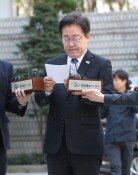Country with dwindling middle class
Country with dwindling middle class
Posted September. 05, 2019 07:30,
Updated September. 05, 2019 07:30
The share of the middle class is an indicator of a nation’s political and economic stability. South Korea has been struggling with a thinning middle-class year after year while the share of people in poverty grows, which has become the root cause of economic dissatisfaction and political instability among the people.
According to a recent announcement by the Ministry of Economy and Finance, the middle-class Koreans account for 58.3 percent of the total populations as of the second quarter of this year. The middle class is defined as those with an income between 50% and 150% of the national median. Its share in South Korea drastically fell from 67.9% in 2015 to 66.2% in 2016, 63.8% in 2017, and 60.2% in 2018. On the other hand, the share of households in poverty – those with an income lower than 50% of the national median – increased from 12.9% in 2015 to 17% in the second quarter of this year.
These are the statistics calling for the review of President Moon Jae-in’s income-related policies on whether or not they are causing adverse effects. The shrinking of the middle class is likely to cause political and social instability while leading to less consumption, investment, and jobs.
Such collapse of the middle class is not limited to South Korea. According to the report published by the Organisation for Economic Co-operation and Development (OECD) in April, the share of the middle class – those with an income between 75% and 200% of the national median – in its member countries decreased from 64% in the mid-1980s to 61% in the mid-2010s. The OECD report said such societal development is causing the disillusionment with the existing political circles and leading to the rise of populism advocating protectionism and nationalism.
A more serious problem is that such a shrinking of the middle class and social instability affect our youths’ future career paths. In the baby boom generation, seven out of 10 households were the middle class while the next generation saw that figure drop to six. It’s unclear whether the following generation will keep the figure over five. It is only natural that children growing up watching the gradual collapse of the middle class would want more stable jobs, rather than pursuing challenging dreams that may bring a sense of achievement at the end.
According to a survey of 1,390 middle school students in Seoul on what they want to be when they grow up, four out of 10 students answered they have no particular preference. Among those who answered they have specific careers in mind, No. 1 answer was a government official at 19.9 percent, which was almost double the share of No. 2 answer – professionals – standing at 10.4 percent. The future of the country where the middle class is thinning, the highest dream of its youths is to become a government official, and college students start studying for civil service exams right after entering college is so grim.







